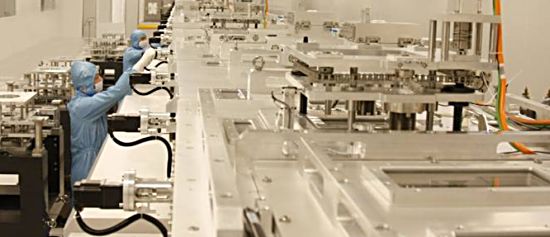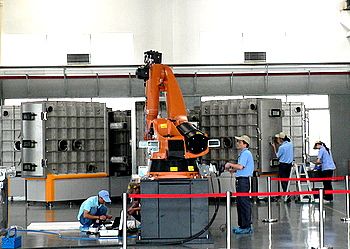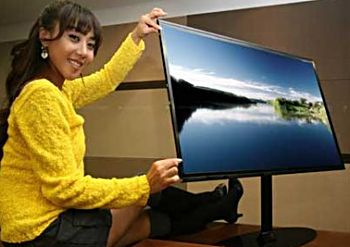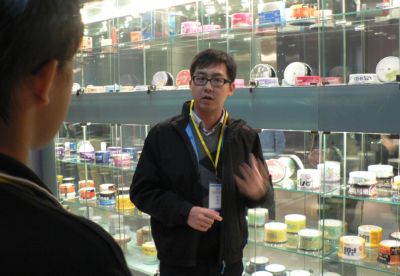
WHILE ANWELL TECHNOLOGIES is just days away from a historic moment in its corporate history – the start of mass production of solar modules – it has also now indicated that another major milestone is just around the corner.
The latter is the start of mass production of OLED panels in Q3 this year, according to Ken Wu, the CFO, in a presentation to fund managers on Wednesday (Mar 10).
This comes about three years after Anwell began developing proprietary technology for its OLED production lines. Its efforts were supported by Chinese government cash grants totaling RMB250 million.
OLEDs are the next generation of flat panel displays, replacing LCDs over the next couple of years in devices such as cell phones and television sets.
Because OLEDs emit light, they do not require a backlight. This means that OLEDs can be made very thin and very power-efficient when compared to LCD (which do require a white backlight).
Anwell has filed over 60 patents from its OLED project which, as is the case with its other businesses, reflect its technological edge. Said Mr Wu: “We own our IPs (intellectual property). We have a unique vertically-integrated model and you won't find another company operating the same model."

Q What business do you do in India and what partners do you have there?
Mr Wu: We have an office in New Delhi. Over the past few years, we have delivered some manufacturing equipment to customers there, including the biggest optical disc manufacturer in India.
Q The OLED business – has it got anything to do with bulbs, with lighting?
Mr Wu: We will be manufacturing OLED flat panel displays. But the technologies can be migrated to lighting, so if a few years from now we announce that we are moving into the lighting industry, don’t be surprised.
Q For the solar business, are you making solar modules or just the equipment for making solar modules?
Mr Wu: Both. Our key advantage is a vertically integrated model.
As there are investment cycles, our strategy will change over time. At some point in time, we may prefer to sell more equipment to the market. At another point in time, we may prefer to keep our equipment production capacity in-house to ourselves. We know when is a good time to invest in capacity.
Q You don’t plan to go into solar energy production?
Mr Wu: As of today, we don’t have such plans. But there may be opportunities for us, especially in China, where some energy companies want to cooperate with us as we have technology and a manufacturing base.

Q Regarding OLED, nobody has been able to make a big OLED display. How are you different in this respect?
Mr Wu: In terms of technology, it’s the same whether it’s a big or small panel. But making a big panel is more difficult in terms of production process. In terms of market size, smaller panels will have a much bigger market in the next few years.
Q Currently, the OLED panels are only on secondary displays of the flip phones. The main displays of are all still TFT. OLED has been around long enough but no one has been able to resolve this for cell-phone size….
Mr Wu: The reason OLED has yet to replace LCD is because of cost. The manufacturing cost will need time to go down further. It will happen with better equipment efficiency, better use of materials. It’s not different from other technological products such as optical discs, solar panels or OLED.
Q Do you expect to have meaningful sales of OLED this year since mass production starts only in Q3?
Mr Wu: We don’t expect a meaningful percentage of sales this year or next year.
Q What about solar modules?
Mr Wu: You can do some calculations. The annual capacity of our solar plant is 40 MW. Right now, the market price for solar modules is US$1.80 per watt. So if everything goes smoothly, the solar business will represent a meaningful share of revenue this year.

Mr Wu: In the past few years, we used the positive cashflow from our optical disc manufacturing business to invest in OLED, Blu-ray and solar. If we had not invested, we would have been a profitable company. But because we have invested heavily, we now have the business opportunities that I have mentioned.
Q The company has announced two MOUs for the sale of its solar modules. When you start mass production this month, are you expecting any difficulty in materializing the sales as these are just MOUs, not contracts?
Mr Wu: The MOUs are for pretty big orders and our capacity this year will not be able to fulfill the requirements. Their projects are ongoing and they may not need our panels this year. For our products in the first two quarters, I don’t expect to sell to these companies – one in America, one in Brazil.
Looking at the demand side, the market is very big. The 40MW capacity we have is small compared to the total demand of the market. And solar panels are by nature commodity products. As long as we have good products and as long as we have a good cost model, there will not be a lot of difficulties for us to break into the market. The customer will find us.







